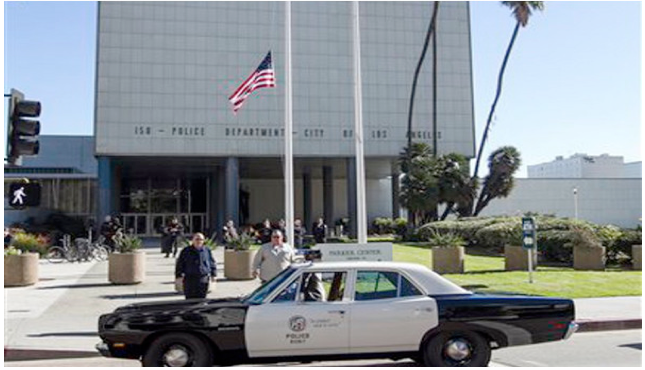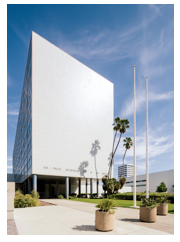CommentsSPECIAL TO CITYWATCH--The story of saving Parker Center is nearly as entangled as the history of the place itself. The former LAPD headquarters, designed by Welton Becket and Associates and built in 1955 in downtown LA’s Civic Center, has been threatened with demolition for years.
Its fate has become mired in matters having less to do with preservation than politics. In and of itself, the political nature of this effort is not surprising. What does set Parker Center apart from other preservation advocacy issues is the lack of a real plan -- by the City and for the City -- other than to get rid of Parker Center.
Can Parker Center be saved and be re-purposed for a new use? Yes, the Los Angeles Conservancy strongly believes that it can and should be, but will it? Given the current direction set by the City administration, it looks more likely that Parker Center will be demolished and for all the wrong reasons. Here’s why.
Plans Designed to Fail
When the Los Angeles police headquarters moved from Parker Center to its new facility in 2009, the preservation community knew that the historic building’s future was very much in question. Yet no clear plan emerged until 2012, when the City, through its Bureau of Engineering (BOE), first released an initial study looking at ways to house upwards of 5,500 City staff near City Hall. The City’s stated need for over a million new square feet of office space is based on a now-dated study calling for 200 square feet per employee.
While preservation and reuse were considered, the environmental review process leaned heavily toward what has become the City’s preferred project: to demolish Parker Center and build a new 450-foot high-rise tower on the site.
Plan 1: Too Small
Besides leaving Parker Center as is -- which wouldn’t come close to meeting the City’s stated project objectives -- the only reuse alternative called for keeping most of Parker Center intact and building a new addition and short tower at the rear. Yet this alternative was essentially designed to fail.
For no apparent reason, the new addition was capped at eleven stories, falling far short of the City’s stated project goal to provide at least a million square feet of office space.
Clearly, this alternative couldn’t meet a basic goal defined by the City. We asked the City, “Why not plan a taller addition that provides more square footage, and why was this the only preservation alternative provided?” We asked these questions repeatedly for the next three years as the process continued to play out. We are still waiting for a response from the City.
Plan 2: Too Expensive
In May 2015, City Councilmember José Huizar instructed the BOE to study another preservation alternative that would more likely deliver what the City wanted: a 750,000-square-foot building. Now joined in the preservation effort by the City’s Cultural Heritage Commission, we were pleased and looked forward to working with the BOE to develop a “win-win” alternative to demolition.
Instead, the BOE quietly developed a new alternative on its own, with no involvement by the preservation community or architects experienced in preservation. Without any advance notice, the BOE took its analysis to the City’s Municipal Facilities Committee in August 2016, which voted to recommend the initial plan to demolish Parker Center.
The committee rejected the new preservation alternative as being too expensive. The City claims that this alternative will cost nearly $107 million more than the City’s preferred project (all-new construction.)
This significant cost differential is surprising, as we know from experience that adaptive reuse often costs much less than all-new construction. We asked to see the detailed analysis to understand how the City arrived at this figure. Apparently there is no such analysis -- nothing substantive has been provided to date.
With no substantiation from the City, we asked experts in private development and adaptive reuse to take a look at the alternative to examine what little details they could.
We believe that the cost estimates in the new alternative are heavily inflated -- described by some as the City “putting their thumb on the scale.” The City makes several assumptions that indefensibly disadvantage preservation, and some just don’t make sense.
For instance, the alternative places a fifteen-story building atop eight stories of above-grade parking, which no private developer would do. It also makes the preservation option nearly 65,000 square feet larger, requiring more parking spaces for the same number of people and further driving up rehabilitation costs.
The City also assumes that the contractor’s fee and general conditions require $14.2 million more for preservation than for all-new construction. There is no basis for this assumption. These types of cost premiums appear throughout the plan’s summary, adding up until the number is so big that no one would ever choose it over a much less expensive option.
UPDATE [January 7, 2017]: Based on a convening on January 6 by the Conservancy of a panel of preservation experts (comprising highly experienced developers, architects, cost estimator, and seismic engineer), we strongly believe the reuse of Parker Center can actually result in a savings of nearly $50 million, and possibly far more. This directly contradicts claims made by the City stating preservation will cost $107 million more than all-new construction. See this fact sheet for details.
Missed Opportunity for Civic Center Master Plan
When City Councilmember José Huizar made his motion in 2015 to study a new preservation alternative, he also directed the City to undertake a plan for the Civic Center. The Conservancy and others had urged the City to develop a cohesive vision for the Civic Center before deciding the fate of Parker Center.
A master plan for the Civic Center is a great opportunity to provide a thoughtful framework for meeting the City and private sector’s needs for years to come. For instance, even if Parker Center were replaced, the City has stated a desire for even more space for City staff. There may be more efficient and thoughtful ways to add this square footage throughout the Civic Center, without relying solely on the Parker Center site to provide more than half of the space the City says it needs.
Most master plans are large-scale, visionary, and based on extensive public input. By contrast, this has been a quiet and quick process involving a limited group of community stakeholders. The community advisory committee (CAC) contains representatives of nearby business improvement districts, including in part Little Tokyo and the Historic Core. The City declined requests by the Conservancy and the Cultural Heritage Commission to participate on the CAC.
Despite the fact that Parker Center’s fate has yet to be decided, the Civic Center master plan process assumed that the building is gone. The absence of Parker Center is a foregone conclusion and a central premise of the master plan -- despite the plan having a stated objective to “balance past and present” as part of a legacy goal for the Civic Center.
This deeply disappointing approach puts the cart before the horse, rather than studying all options from the beginning. It also presumes that the City Council will vote for Parker Center’s destruction before they even consider the master plan.
In many ways, this is not a true master plan for the entire Civic Center. It addresses only the core of the Civic Center, primarily the city-owned properties. The plan focuses mainly on three blocks consisting of the Los Angeles Mall, City Hall East and South, and the block containing the 911 Call Center, Metro Detention, and Parker Center. From what we have been able to assess, the plan proposes a series of high-rise towers, as a companion to the one envisioned at the Parker Center site.
We anticipate a final plan for the Civic Center to be released in January 2017. We also anticipate members of the CAC to support the plan, in part because of how the new development will be limited and what it can offer as a buffer.
For some, particularly members of the Little Tokyo community who are most directly affected, Parker Center is essentially a pawn in a game of chess. Agreeing to support the demolition of Parker Center can help ensure that no new development spills over into Little Tokyo in the future. The “master plan” would also provide more than a thousand new parking spaces for the area.
Reluctance by members of the Little Tokyo community to preserve Parker Center is understandable, given the neighborhood’s negative association with the building. Parker Center came into being through urban renewal and the destruction of two of the most vibrant blocks in the community.
In 2014, the Little Tokyo Historical Society joined the Conservancy in urging the City to support a preservation alternative, in part to tell the story of what happened to their community. At the time, members of the society expressed a desire to own their past, rather than wiping it away through yet another demolition. Yet in recent months, as part of the Civic Center master plan process, the Historical Society has changed its position and now supports Parker Center’s demolition.
We Can Do Better by Working Together
The likely demolition of this highly significant building will happen not for valid reasons, and certainly not from a lack of trying by the Conservancy, the Cultural Heritage Commission, and many others. It will happen as the result of a misguided, flawed, and opaque government process designed in many ways to ensure the destruction of Parker Center.
In a one-two punch, the replacement project will likely go before the City’s Entertainment and Facilities Committee on Tuesday, January 10, 2017. We expect the committee to recommend the project, and for the full City Council to cast its final vote very soon thereafter—perhaps within days.
Meanwhile, the Historic-Cultural Monument nomination for Parker Center is still pending, waiting to be scheduled before the City Council’s Planning and Land Use Management Committee. The Cultural Heritage Commission (CHC) re-submitted the nomination in September 2016, after a procedural error by the City essentially voided the initial nomination submitted by the CHC in 2014. Yet the proposed project calling for the building’s demolition will likely be approved before its designation as a landmark.
It doesn’t have to be this way. There is a better option for everyone than what’s now on the table. By working together, we can find a solution for Parker Center. Let’s engage and bring in the preservation expertise to begin addressing the various challenges and opportunities for this project, from rehabilitation and costs to community connectivity as part of a larger Civic Center vision.
How You Can Help
Please call and request a meeting with Councilmember José Huizar, Council President Herb Wesson, and Mayor Eric Garcetti and strongly urge their support for Parker Center and its preservation through an adaptive reuse project. Parker Center is located within Councilmember Huizar’s district and his position especially matters as other councilmembers are likely to support his stance.
City Councilmember Jose Huizar
Phone: (213) 473-7014
Email: [email protected]
Facebook: https://www.facebook.com/huizar.jose/
Chief of Staff Paul Habib, [email protected]City Council President Herb Wesson
Phone: (213) 473-7010
Email: [email protected]
Facebook: https://www.facebook.com/HerbWessonJr/
Chief of Staff Deron Williams, [email protected]Mayor Eric Garcetti
Phone: (213) 978-0600
Email: [email protected]
Facebook: https://www.facebook.com/garcetti
(Adrian Scott Fine is director of advocacy for the Los Angeles Conservancy.) Prepped for CityWatch by Linda Abrams.
Sidebar
Our mission is to promote and facilitate civic engagement and neighborhood empowerment, and to hold area government and its politicians accountable.

 CityWatch Los Angeles
Politics. Perspective. Participation.
CityWatch Los Angeles
Politics. Perspective. Participation.
29
Mon, Dec














